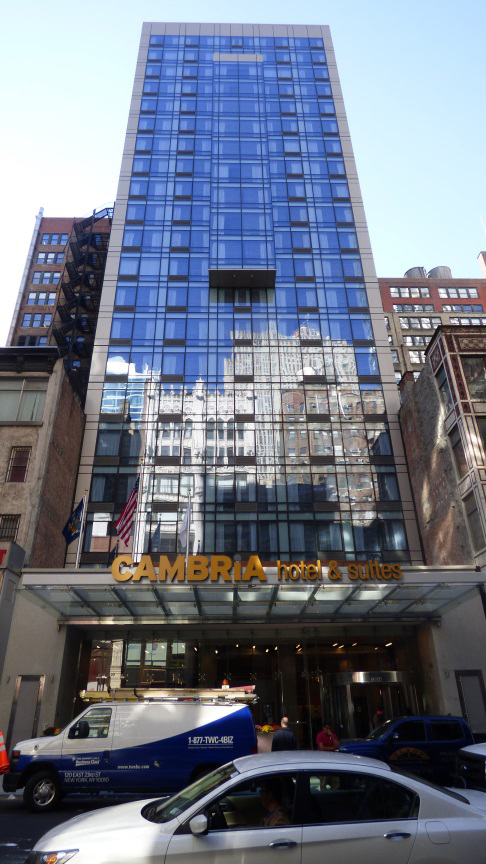News:
Green Buildings
Posted: September 22, 2014
Innovative Empire State Building program cuts $7.5m in energy costs
The Empire State Building has surpassed the energy savings guaranteed through its innovative energy-efficiency program for the third consecutive year. This year, the iconic property beat its energy-efficiency guarantee by 15.9%, saving $2.8 million.
Over the past three years, the program has generated a total of $7.5 million in energy savings at the landmark building. The savings is the result of continued enhancement of the iconic building's new systems and the addition of many new tenants occupying hundreds of thousands of s/f of office space retrofitted according to program guidelines.
In 2009, the Empire State Building, president Bill Clinton and mayor Michael Bloomberg launched a comprehensive retrofit at the landmark property to reduce costs, increase real estate value and protect the environment. In 2011, the Empire State Building beat its year-one energy-efficiency guarantee by 5%, saving $2.4 million. In year two, the iconic property surpassed its energy-efficiency guarantee by nearly 4%, saving $2.3 million.
As with the first-year and second-year results, all information and measurement and verification reports can be viewed at www.esbsustainability.com.
"The Empire State Building retrofit project has dramatically exceeded projected energy savings for the third straight year, reducing costs by millions of dollars," said Anthony Malkin, Empire State Realty Trust chairman, president and CEO. "As we continue our energy efficient installations for incoming tenants, we are confident we will meet and exceed our completed project goal of saving $4.4 million each year. As for now, we are ahead of our projections and that means more savings and more returns on our investments to date."
In 2009, Empire State Realty Trust and the Clinton Climate Initiative Cities program, an aligned partner of the C40 Cities Climate Leadership Group, assembled a coalition of leading organizations focused on energy efficiency and sustainability. The team, comprised of the Empire State Building, Jones Lang LaSalle (JLL), Johnson Controls (JCI), and Rocky Mountain Institute (RMI), developed the energy efficiency program that has been implemented at the Empire State Building.
"The Empire State Building retrofit project is a leading example of the power of C40's network approach; its continued performance has provided hard evidence for mega cities the world over taking steps to improve building energy efficiency in the private sector. This is truly an example to follow for other ambitious mega cities," said Mark Watts, executive director, C40 Cities Climate Leadership Group.
"Five years into the retrofit of the Empire State Building, we have seen carbon emission reductions and cost savings that show this is a model for the rest of the country," said former President Clinton. "Not only do investments like like this help protect the environment and put people back to work, they pay for the cost of the improvements and generate additional savings into the future."
The core base building energy-efficiency retrofit at the Empire State Building is complete, with the balance of the projects to be finished as new tenants build out high-performance workspaces. Once all tenant spaces are upgraded, the building is expected to save at least $4.4 million a year, at least a 38% reduction of energy use.
RMI's pioneering, whole-systems approach to the Empire State Building project helped identify how a "deep" energy retrofit could be achieved using a similar capital expenditure to a traditional retrofit. By incorporating elements beyond just energy cost savings, the retrofit achieved a Class-A rating and the increased rents that come with it and provided a replicable example of how other buildings can be both energy efficient and profitable—and healthier, more productive and more lucrative workplaces.
Over the past three years, the energy retrofit model has been replicated throughout the U.S. JCI and JLL jointly implemented the program at all 13 properties in Empire State Realty Trust's New York metropolitan-area commercial portfolio, as well as One Worldwide Plaza in New York. JCI continues to implement this model at public and private sector buildings around the world and actively promotes the approach and results in leading global publications and conferences. JLL has also instituted the model at more than 50 other properties across the nation, including The Moscone Center in San Francisco and Chicago Union Station, doubling the number of projects it has worked on in the past year alone.
"Investing in energy efficiency for any type of building - from the Empire State Building to the local school or hospital - provides building owners with significant financial returns and creates comfortable and efficient environments," said Clay Nesler, vice president, Global Energy and Sustainability, Johnson Controls. "Performance contracting provides the model to invest in upgrades with no upfront costs to the owner and the ability to pay for the project with the savings. It's a risk free model that everyone should take advantage of."
The retrofit has been a key differentiator for the Empire State Building and helped attract game changing tenants, including LinkedIn, Skanska, LF USA, Coty Inc., the Federal Deposit Insurance Corp., and Shutterstock. These tenants sought space that reflected their sustainability values, provided more comfort for employees, and allowed them to monitor and control their energy use.
"This past year, the project partners were able to significantly boost energy savings at the Empire State Building," said Raymond Quartararo, international director at JLL. "We were able to implement some of the automation capabilities of the new equipment and building management system. In addition, hundreds of thousands of square feet of tenant spaces were built out to meet the building's high-performance environmental guidelines."
The retrofit project focused on eight innovative improvement measures addressing core building infrastructure, common spaces and tenant suites. Improvement measures performed by Johnson Controls and JLL included the refurbishment of all 6,514 windows, installation of insulation behind all radiators, a chiller plant retrofit, new building management systems controls, new revenue-grade meters serving the entire building, and a web-based tenant energy management system.
"It is exciting to see the Empire State Building example being replicated," said RMI Co-founder and chief scientist Amory Lovins. "With the country's 120 million buildings consuming 42% of our nation's total energy and 72% of our electricity we must accelerate the adoption of deep energy saving retrofits—even at the pace of hundreds of buildings at a clip across entire portfolios."
In the United States and other developed nations, around 40% of total energy use is consumed by buildings, according to the World Business Council for Sustainable Development. In dense urban settings like New York, commercial buildings account for up to 75% of energy used.
Tags:
Green Buildings
MORE FROM Green Buildings
IREON Insights: DURA Architectural Signage manufactures and delivers over one million signs
Long Island City, NY Since its founding in 1955, IREON member DURA Architectural Signage has proudly manufactured and delivered more than one million signs to clients across a wide range of industries. From architectural interior signage to large-scale exterior installations, their work can be seen in corporate

Quick Hits







.gif)


.jpg)
.gif)